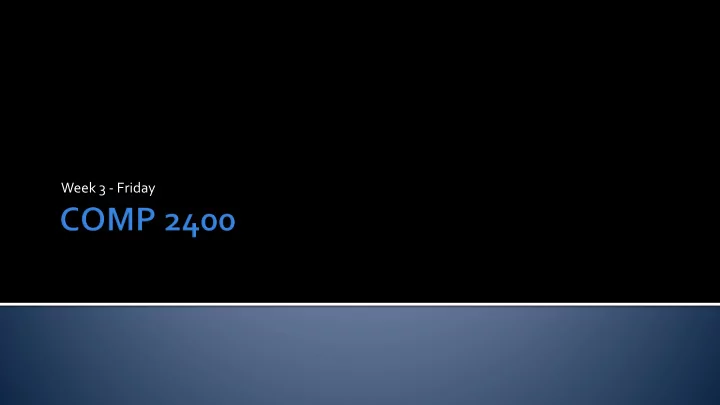

Week 3 - Friday
What did we talk about last time? Control flow Selection if statements switch statements Loops while for do - while
Unix was not designed to stop its users from doing stupid things, as that would also stop them from doing clever things. Doug Gwyn
Loops can go on forever if you aren't careful int n = 40; int i = 1; while( i <= 40 ) { printf("%d", i); // Supposed to print all the numbers // less than 40, but i never increases }
Infinite for loops are unusual, but possible: for( ; ; ) printf("Hey!"); This situation is more likely: int i; for(i = 0; i < 10; ++i ) { printf("%d", i); // Lots of other code --i; // Whoops, maybe changed from while? }
Overflow and underflow will make some badly written loops eventually terminate int i; for( i = 1; i <= 40; --i ) // Whoops, should have been ++i printf("%d", i);
Being off by one is a very common loop error int i; for( i = 1; i < 40; ++i ) // Runs 39 times printf("%d", i);
If the condition isn't true to begin with, the loop will just be skipped int i; for( i = 1; i >= 40; i++ ) // Oops, should be <= printf("%d", i);
A misplaced semicolon can cause an empty loop body to be executed int i; for( i = 1; i <= 40; i++ ); // Semicolon is wrong { printf("%d", i); } Everything looks good, loop even terminates But, only one number will be printed: 41 Misplaced semicolon usually makes a while loop infinite
The break command is a necessary part of the functioning of a switch statement But, it can also be used to jump out of a loop Whenever possible (i.e. always), it should not be used to jump out of a loop Everyone once in a while, it can make things a little clearer, but usually not Loops should have one entry point and one exit for(value = 3; value < 1000; value += 2) { … if( !isPrime(value) ) break; } for(value = 3; value < 1000 && isPrime(value); value += 2) { … }
The continue command is similar to the break command It will cause execution to jump to the bottom of the loop If it is a for loop, it will execute the increment For all loops, it will return to the top if the condition is true It makes things easier for the programmer up front, but the code becomes harder to follow The effect can be simulated with careful use of if statements
A goto command jumps immediately to the named label Unlike break and continue, it is not a legal command in Java Except in cases of extreme ( EXTREME ) performance tuning, it should never be used Spaghetti code results for(value = 3; value < 1000; value += 2) { if( !isPrime(value) ) goto stop; } printf("Loop exited normally.\n"); stop: printf("Program is done.\n");
Write a loop that counts the number of digits in a number Hint: Keep dividing the number by 10 until you get 0
A system call is a way to ask the kernel to do something Since a lot of interesting things can only be done by the kernel, system calls must be provided to programmers via an API When making a system call, the processor changes from user mode to kernel mode There is a fixed number of system calls defined for a given system
The most common implementation of the Standard C Library is the GNU C Library or glibc Some of the functions in the glibc perform systems calls and some do not There are slight differences between the versions of the glibc Microsoft also has an implementation of the Standard C Library that doesn't always behave the same
There are no exceptions in C Instead, when a system call fails, it usually returns -1 To find out why the system call failed First, make sure you #include <errno.h> Then check the value of the integer errno in your program after the system call fails Use the man pages to determine what a given value of errno means The perror() function is often used to print errors instead of printf() It sends the output to stderr instead of stdout
#include <stdio.h> #include <fcntl.h> #include <errno.h> int main(){ int fd = open("eggplant.txt", O_WRONLY | O_CREAT | O_EXCL); if (fd == -1) { perror("Failure to create file: "); if( errno == EACCES ) perror("Insufficient privileges\n"); else if( errno == EEXIST ) perror("File already exists\n"); else perror("Unknown error\n"); exit(EXIT_FAILURE); } return 0; }
C has a feature called typedef which allows a user to give a new name to a type System types are often created so that code is portable across different systems The most common example is size_t , which is the type that specifies length It's usually the same as unsigned int There are named types for process IDs ( pid_t ), group IDs ( gid_t ), user IDs ( uid_t ), time ( time_t ), and many others
Functions
Michael Thornton talk: How to get a Software Engineering Job Tuesday, February 4, 4-6 p.m. The Point 113 Read K&R chapter 4 Finish Project 1 Due tonight by midnight!
Recommend
More recommend